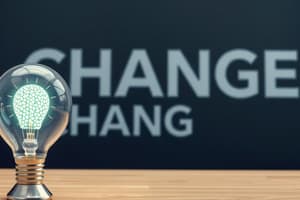Podcast
Questions and Answers
What is the primary focus of organizational development (OD)?
What is the primary focus of organizational development (OD)?
- Improving interpersonal work relationships (correct)
- Enhancing technology use
- Changing financial strategies
- Increasing market share
Which of the following is NOT a reason for resistance to change?
Which of the following is NOT a reason for resistance to change?
- Habit
- Boredom with routine (correct)
- Concern over personal loss
- Uncertainty
Which technique is used when resisters have the expertise to contribute to change efforts?
Which technique is used when resisters have the expertise to contribute to change efforts?
- Participation (correct)
- Manipulation
- Education and communication
- Coercion
What advantage does education and communication provide in managing resistance to change?
What advantage does education and communication provide in managing resistance to change?
Which of the following disadvantages is associated with facilitation and support?
Which of the following disadvantages is associated with facilitation and support?
What is a potential disadvantage of using coercion as a technique to manage resistance?
What is a potential disadvantage of using coercion as a technique to manage resistance?
What is the primary focus of Action Research in organizational change?
What is the primary focus of Action Research in organizational change?
When is negotiation an effective tactic to manage resistance?
When is negotiation an effective tactic to manage resistance?
What does the Appreciative Inquiry approach emphasize when envisioning organizational change?
What does the Appreciative Inquiry approach emphasize when envisioning organizational change?
Which factor is NOT related to effective communication during times of change?
Which factor is NOT related to effective communication during times of change?
What is a possible outcome of manipulation and co-optation?
What is a possible outcome of manipulation and co-optation?
How can organizational leadership help in reducing stress among employees?
How can organizational leadership help in reducing stress among employees?
What response do employees typically have to stress in the workplace?
What response do employees typically have to stress in the workplace?
Which job-related factor is a common stressor for employees?
Which job-related factor is a common stressor for employees?
Which of the following is considered a positive way to deal with bad news during organizational change?
Which of the following is considered a positive way to deal with bad news during organizational change?
What is the definition of organizational change?
What is the definition of organizational change?
What is one factor NOT mentioned as essential for effective leadership in organizational change?
What is one factor NOT mentioned as essential for effective leadership in organizational change?
What metaphor describes a planned approach to managing change?
What metaphor describes a planned approach to managing change?
Which of the following is a primary external force that creates the need for change?
Which of the following is a primary external force that creates the need for change?
Who can act as a change agent in an organization?
Who can act as a change agent in an organization?
What is a key part of the Three-Step Change Process?
What is a key part of the Three-Step Change Process?
What does the White-Water Rapids Metaphor signify in the context of organizational change?
What does the White-Water Rapids Metaphor signify in the context of organizational change?
In managing resistance to change, which approach is generally most effective?
In managing resistance to change, which approach is generally most effective?
Which of these is described as an internal force that may necessitate organizational change?
Which of these is described as an internal force that may necessitate organizational change?
Which method can be used to help reduce employee stress effectively?
Which method can be used to help reduce employee stress effectively?
What is a key factor in facilitating creativity in organizations?
What is a key factor in facilitating creativity in organizations?
Which structural variable is most likely to positively influence innovation?
Which structural variable is most likely to positively influence innovation?
Which of the following best describes the relationship between creativity and innovation?
Which of the following best describes the relationship between creativity and innovation?
Which approach would likely enhance an employee's creative performance?
Which approach would likely enhance an employee's creative performance?
What is one potential drawback to innovation in an organization?
What is one potential drawback to innovation in an organization?
What aspect is essential for reducing confusion during job selection?
What aspect is essential for reducing confusion during job selection?
Which of the following is a benefit of wellness programs in organizations?
Which of the following is a benefit of wellness programs in organizations?
Flashcards
Organizational change
Organizational change
Any alteration of people, structure, or technology in an organization.
Change agent
Change agent
Someone who manages the change process, acting as a catalyst.
Calm Waters Metaphor
Calm Waters Metaphor
Change is planned and takes steps: unfreezing, changing, refreezing.
White-Water Rapids Metaphor
White-Water Rapids Metaphor
Signup and view all the flashcards
External forces for change
External forces for change
Signup and view all the flashcards
Internal forces for change
Internal forces for change
Signup and view all the flashcards
Change process steps
Change process steps
Signup and view all the flashcards
Change agent roles
Change agent roles
Signup and view all the flashcards
OD Techniques
OD Techniques
Signup and view all the flashcards
Survey Feedback
Survey Feedback
Signup and view all the flashcards
Process Consultation
Process Consultation
Signup and view all the flashcards
Team-Building
Team-Building
Signup and view all the flashcards
Intergroup Development
Intergroup Development
Signup and view all the flashcards
Reasons for Resistance to Change
Reasons for Resistance to Change
Signup and view all the flashcards
Managing Resistance - Involvement
Managing Resistance - Involvement
Signup and view all the flashcards
Managing Resistance - Training
Managing Resistance - Training
Signup and view all the flashcards
Action Research
Action Research
Signup and view all the flashcards
Appreciative Inquiry
Appreciative Inquiry
Signup and view all the flashcards
Four-D Model
Four-D Model
Signup and view all the flashcards
Stress
Stress
Signup and view all the flashcards
Functional Stress
Functional Stress
Signup and view all the flashcards
Stressors
Stressors
Signup and view all the flashcards
Role Conflict
Role Conflict
Signup and view all the flashcards
Role Overload
Role Overload
Signup and view all the flashcards
Employee Assistance Programs (EAPs)
Employee Assistance Programs (EAPs)
Signup and view all the flashcards
Wellness Programs
Wellness Programs
Signup and view all the flashcards
Realistic Job Previews
Realistic Job Previews
Signup and view all the flashcards
Organizational Communications
Organizational Communications
Signup and view all the flashcards
Performance Planning Program
Performance Planning Program
Signup and view all the flashcards
Job Redesign
Job Redesign
Signup and view all the flashcards
Creativity
Creativity
Signup and view all the flashcards
Innovation
Innovation
Signup and view all the flashcards
Study Notes
Fundamentals of Management - Chapter 7: Managing Innovation and Change
- Organizational change is any alteration of people, structure, or technology in an organization
- Change can be categorized as structural, technological, or related to people. Structural changes impact work specialization, departmentalization, chain of command, span of control, centralization, formalization and job redesign. Technological change includes alterations to work processes, and equipment. Changes to people affect attitudes, expectations, perceptions, and behaviors.
- External factors like the marketplace, government regulations, technology, labor markets, and economic shifts drive organizational change. Internal factors include changes in strategy, the workforce, and employee attitudes.
- A change agent is someone who acts as a catalyst and assumes responsibility for managing the process. Any manager can be a change agent. Change agents might also include internal staff specialists or external consultants.
- The Calm Waters Metaphor suggests change is planned and requires unfreezing the status quo, changing to a new state, and refreezing to make the change permanent. The three-step process involves unfreezing, changing, and refreezing.
- The White-Water Rapids Metaphor portrays change as constant and uninterrupted, like navigating a raging river.
- Organizational development (OD) is a technique or program used to change people or interpersonal work relationships. Popular OD efforts include survey feedback, process consultation, team-building, and intergroup development.
- Reasons why people resist change include uncertainty, habit, personal loss, and belief that change isn't in the organization's best interest. Resistance can be reduced by involving people in the change, offering training, and allowing for revisions.
- Techniques used to reduce change resistance include education and communication, participation, facilitation and support, negotiation, manipulation and co-option, and coercion.
- Action research, based on changing employee attitudes and behaviors, is a change process that involves diagnosing the need for change; introducing an intervention; and evaluating the changes. This involves gathering data, planning actions, taking steps, receiving feedback and redesigning systems.
- Appreciative inquiry focuses on organizations' strengths to create a vision of the future. It uses a four-step process (Discovery, Dreaming, Designing, Delivering) to identify strengths, envision possible futures, develop objectives for changes, and deliver the change.
- Managers make mistakes in leading change by being unaware of gaps between employee knowledge and what's actually happening, not creating awareness of the need for change, unrecognized internal conflict, lacking a vision to create desire for change, not adequately communicating the change or not empowering employees. Problems also arise in the refreezing stage for example stopping changes too soon, initiating new changes before previous ones are finished or not supporting the changes in the organization's culture.
- Effective communication during change includes CEO commitment, managerial action matching words, two-way communication, emphasizing face-to-face interactions, shared responsibility for communication, positive methods for communicating bad news, tailoring messages to audiences, and treating communication as a continuous process.
- Stress is anxiety over demands, constraints, or opportunities. Positive stress allows for peak performance at critical times. Job-related factors that cause stress include task demands, role demands (role conflicts, role overload, role ambiguity), interpersonal demands, organizational structure, and organizational leadership.
- Stress can be reduced through job-related controls like employee selection, job design, and working conditions. External support programs such as employee assistance programs (EAPs), and wellness programs can assist with personal stress factors. Techniques like matching skills to job needs, offering realistic job previews, improving communications, developing performance plans, and job redesign can all help.
Creativity and Innovation
- Creativity is the ability to produce novel and useful ideas. It's a four-step process involving perception, incubation, inspiration, and innovation.
- Innovation is the process of implementing a creative idea into a useful product or service.
- Innovative organizations often have cultures that accept ambiguity, tolerate the impractical, minimize external restrictions, tolerate risks and conflict, focus on ends, use an open system, and give positive feedback.
- Innovative organizations utilize human resource practices that promote training and development, offer job security, and encourage "idea champions".
- Design thinking offers a process for inventing new things. It stresses understanding deeply what customers need and turning insights into usable products.
Studying That Suits You
Use AI to generate personalized quizzes and flashcards to suit your learning preferences.
Related Documents
Description
This quiz explores the key concepts of managing innovation and change within organizations as detailed in Chapter 7. Topics include types of organizational change, influencing factors, and the role of change agents. Test your knowledge on how these elements interact to drive effective change.




